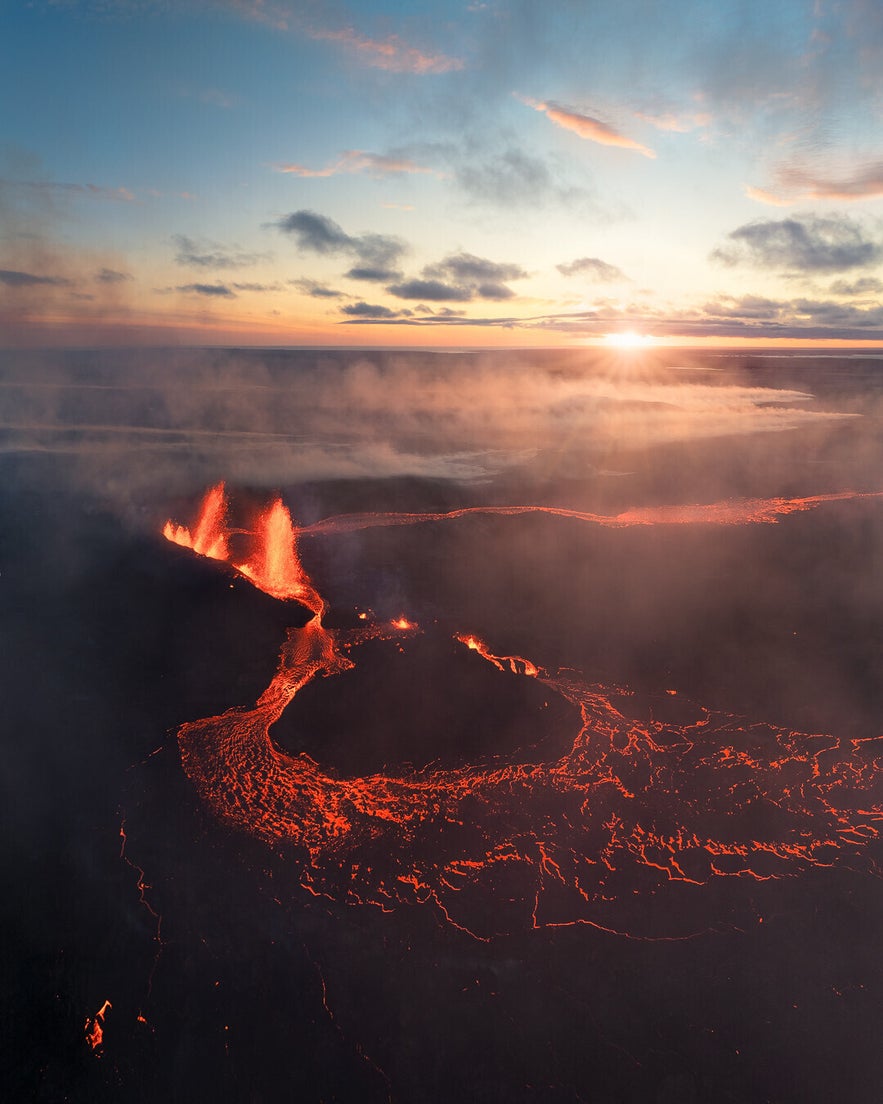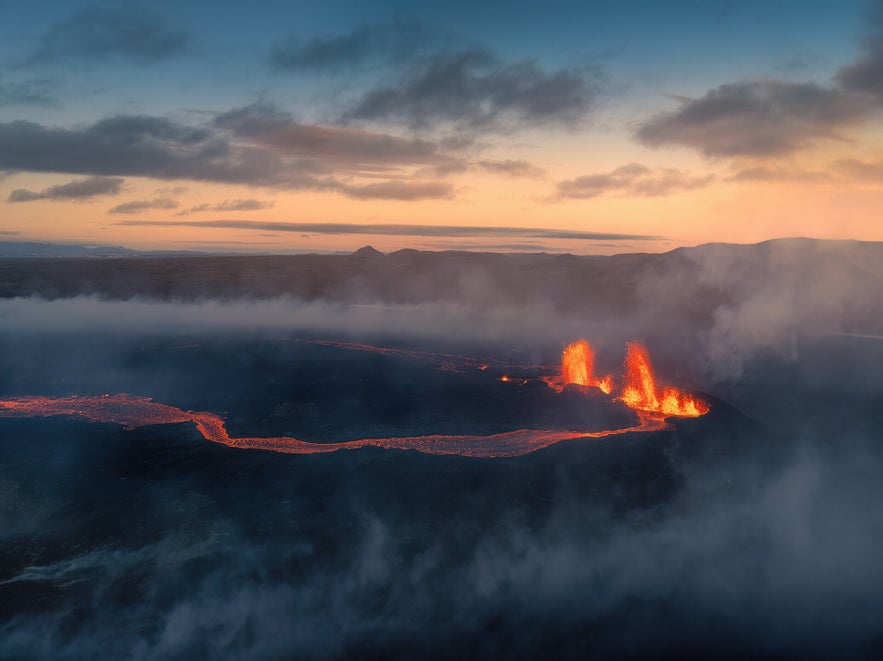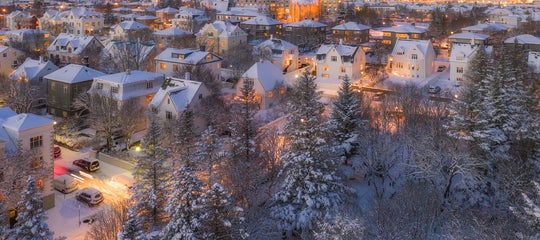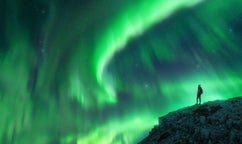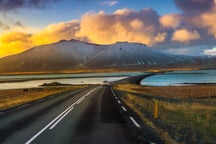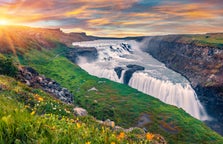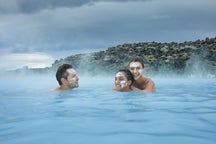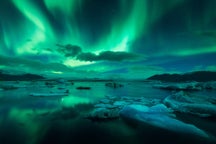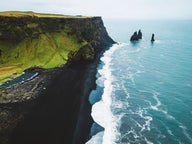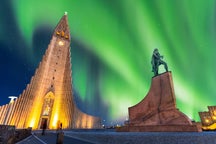The Reykjanes Peninsula has become one of Iceland’s most dynamic travel regions in recent years, experiencing ongoing volcanic activity with 12 eruptions since 2021, including the ninth eruption along the Sundhnukagigar Craters in July 2025.
This rare period of frequent eruptions offers travelers a unique opportunity to witness active geology in real time.
As a result, Reykjanes has turned into a major hub for volcano tours, including this guided volcano hike, the convenient volcano shuttle, and the unforgettable volcano helicopter tour. Clearly marked hiking trails now allow visitors to safely view recent eruption sites up close, making this one of the most accessible volcanic hiking areas in Iceland.
Why You Can Trust Our Content
Guide to Iceland is the most trusted travel platform in Iceland, helping millions of visitors each year. All our content is written and reviewed by local experts who are deeply familiar with Iceland. You can count on us for accurate, up-to-date, and trustworthy travel advice.
While several eruptions have occurred near the town of Grindavik and attracted international attention, they have been anticipated by Icelandic authorities. Protective measures are in place to safeguard nearby infrastructure, and daily life in Iceland continues largely unaffected.
Traveling to Iceland remains safe, with flights operating normally and no risk to visitors, even during live eruptions.
Read on to learn more about the recurring eruptions of the Sundhnukagigar craters throughout 2024 and into 2025. For a broader context, you can also explore our guide to the volcanic history of Iceland.
- See also: Guide to the 2021 Volcanic Eruption by Fagradalsfjall and the 2022 Fagradalsfjall Volcano Eruption Guide
Key Takeaways
-
The Reykjanes Peninsula has experienced frequent volcanic eruptions since 2021, including multiple eruptions at Sundhnukagigar in 2024 and 2025.
-
Despite the activity, travel to Iceland has remained safe, with flights, tours, and major attractions operating normally throughout the eruption period.
-
Sundhnukagigar is one of the most accessible volcanic areas in Iceland, with marked hiking trails, shuttle access, and helicopter tours allowing visitors to safely see recent lava fields.
-
Authorities closely monitor volcanic activity, use protective barriers to safeguard infrastructure, and provide early warnings when conditions change.
-
As of 2026, there is no active eruption, and while magma continues to gather underground, there are no signs of an imminent event.
-
Grindavik has gradually reopened, some residents have returned, and recovery efforts are ongoing, reflecting increased stability in the area.
-
For travelers interested in geology, the Reykjanes eruptions offer a rare chance to witness Iceland’s volcanic landscape evolving in real time, without disrupting typical travel plans.
Hiking to Sundhnukagigar Volcano Area
 The Sundhnukagigar Craters are the most active volcanic area in Iceland as of 2023–2026, offering travelers a rare chance to hike near recent lava flows and fresh craters. Hiking here provides a front-row view of Iceland’s evolving volcanic landscape.
The Sundhnukagigar Craters are the most active volcanic area in Iceland as of 2023–2026, offering travelers a rare chance to hike near recent lava flows and fresh craters. Hiking here provides a front-row view of Iceland’s evolving volcanic landscape.
It's possible to see Sundhnukagigar and the surrounding eruption sites with the volcano shuttle, but if you're planning to hike to the volcano area without a guide, it's important to understand the designated routes and essential safety considerations.
In previous years, several hiking paths have been established to see the nearby Fagradalsfjall Volcano and Litli Hrutur Volcano, which erupted between 2021 and 2023. In July 2025, a new path was opened along the Sundhnukagigar Lava Field. Each trail is marked by color on the official map below, and varies in length, difficulty, and scenery.
The path to see the Sundhnukagigar Craters is called "Trail B". It's dark blue on the map. It starts from the P1 parking area near Mt. Fagradalsfjall and leads directly toward the new lava field and Sundhnukagigar Crater Row.
The Sundhnukagigar Volcano trail has two viewpoints:
-
B1 viewpoint: Hiking distance is 2.9 miles (4.7 kilometers) one way
-
B2 viewpoint: Hiking distance is 3.7 miles (6.1 kilometers) one way
The hike is well-marked and offers stunning views of the active lava zone and the craters that have formed in recent years. Be sure to stay on the designated trail, as sections nearby may be closed off for safety due to unstable ground or volcanic gas.
Trails to other eruption sites in the vicinity include:
-
Path A – Fagradalsfjall Route (Pink on map): A popular alternative route, Path A is a moderately challenging 4–5 miles hike each way (6–8 kilometers), with rough terrain and some steep sections. It brings hikers near earlier eruption sites and can connect with the newer paths for broader views.
-
Path C – Langihryggur Ridge (Green on map): This shorter 2.4-mile (4 kilometers) route leads to a scenic overlook with wide views across multiple eruption zones. While it doesn’t take you to the craters themselves, it’s ideal for a quick hike with great photo opportunities.
-
Path E – Meradalir Route: This is the longest and most physically demanding option, covering 11–12.5 miles round-trip (18–20 kilometers) and requiring 5–6 hours to complete. It includes sections over moss-covered lava and is suitable only for fit, experienced hikers.
-
Natthagi Trails: These simple 1.2-mile paths (2 kilometers) offer easy access to the edge of an older lava field. There’s no crater view here, but the area is scenic and suitable for less experienced hikers or those short on time.
Sundhnukagigar Volcano Trails Parking
There are three official parking lots for the volcano trail access:
-
P1 (Fagradalsfjall) – Ideal for Path A and Path B to Sundhnukagigar.
-
P1 (Natthagi) – Alternative option for Path A and B, and convenient for short lava field walks.
-
P2 (Stori-Leirdalur) – Best for Path E and alternate Natthagi routes.
All lots require payment via the Parka app, and license plate monitoring is enforced. Make sure to pay on arrival to avoid fines.
Safety Tips for Reykjanes Volcano Area Hikes
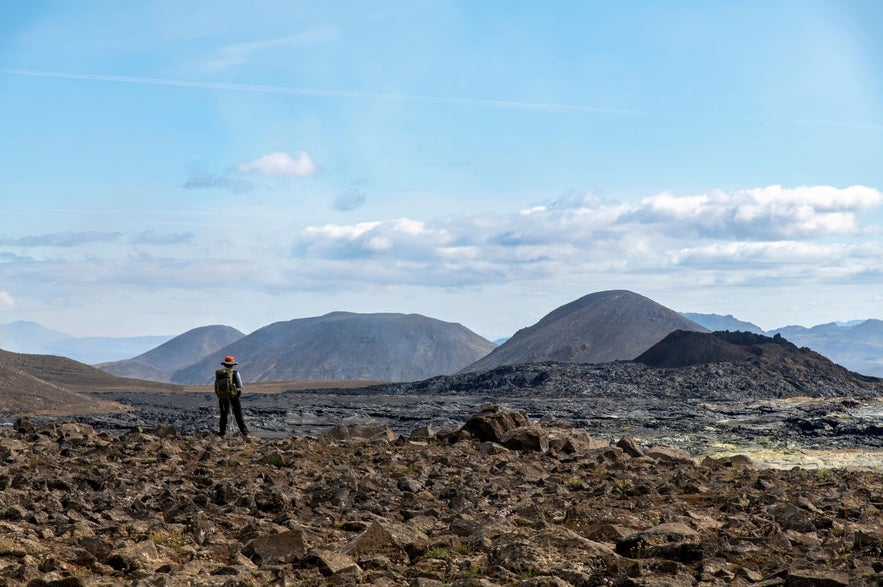 Visiting an active volcanic area is an unforgettable experience, but it's important to pay attention to safety. Keep the following in mind:
Visiting an active volcanic area is an unforgettable experience, but it's important to pay attention to safety. Keep the following in mind:
-
Wear proper footwear: Trails are rocky, uneven, and often slippery. Hiking boots are essential.
-
Check the weather: Keep an eye on the weather forecast as conditions can change rapidly. Dress in layers and carry waterproof gear.
-
Stay on marked trails: Venturing off-path is dangerous due to unstable ground and volcanic gases. Some areas around Sundhnukagigar are still closed off for safety.
-
Monitor air quality and trail status: Before your hike, check sites like SafeTravel for safety updates and Loftgaedi for air quality alerts.
-
Expect limited lighting: There’s no artificial lighting on the trails. A headlamp is recommended if hiking in low-light conditions.
2024 - 2025 Volcanic Eruptions at Sundhnukagigar
The first eruption at Sundhnukagigar took place in December 2023, but 2024 was marked by a series of repeated eruptions. Only a few months separated each event, and most followed a similar pattern, starting with intense activity before quickly subsiding.
Volcanic activity slowed toward the end of the year, with two additional eruptions occurring in 2025. However, magma continues to accumulate beneath the surface, meaning further eruptions remain possible in 2026. Below is a complete overview of all Sundhnukagigar eruptions from 2024 through today.
February 8, 2024
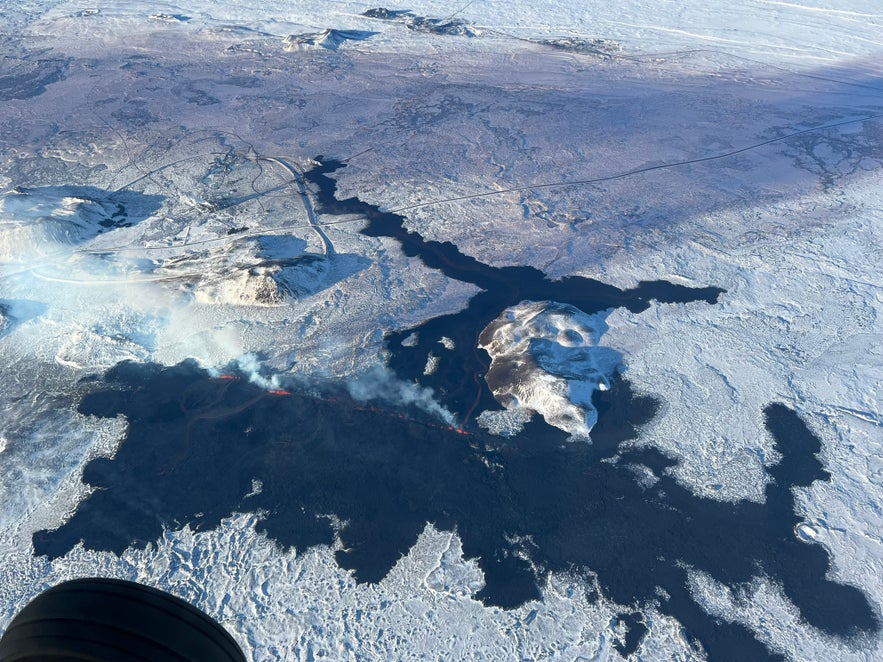 The fissure that opened by the Sundhnukagigar crater row on February 8th was around 1.8 miles long (3 kilometers), with dramatic plumes of lava rising to heights of 164-196 feet (50-80 meters). Unlike the previous eruption in Hagafell, which had taken place close to the town of Grindavik, this new eruption is further north, with a lava flow heading mostly west.
The fissure that opened by the Sundhnukagigar crater row on February 8th was around 1.8 miles long (3 kilometers), with dramatic plumes of lava rising to heights of 164-196 feet (50-80 meters). Unlike the previous eruption in Hagafell, which had taken place close to the town of Grindavik, this new eruption is further north, with a lava flow heading mostly west.
According to the Icelandic Meteorological Office, the eruption was similar to the Hagafell eruption, although a little less powerful, and it followed a similar pattern to the previous Sundhnukagigar eruption of December 2023.
No lives were in danger from the eruption. However, the lava flow reached the Grindavikurvegur road and destroyed a water pipe that supplied the towns on the edge of the Reykjanes peninsula with hot water and heating. This led to around four days of no heating before a new pipeline could be established.
The lava flow did not cause damage to the town of Grindavik, the Blue Lagoon, or the Svartsengi power station, and construction crews had erected protective walls as preventative measures in response to the volcanic activity in the region. While the eruption was short-lived, the Sundhnukagigar area would not stay quiet for long.
March 16, 2024
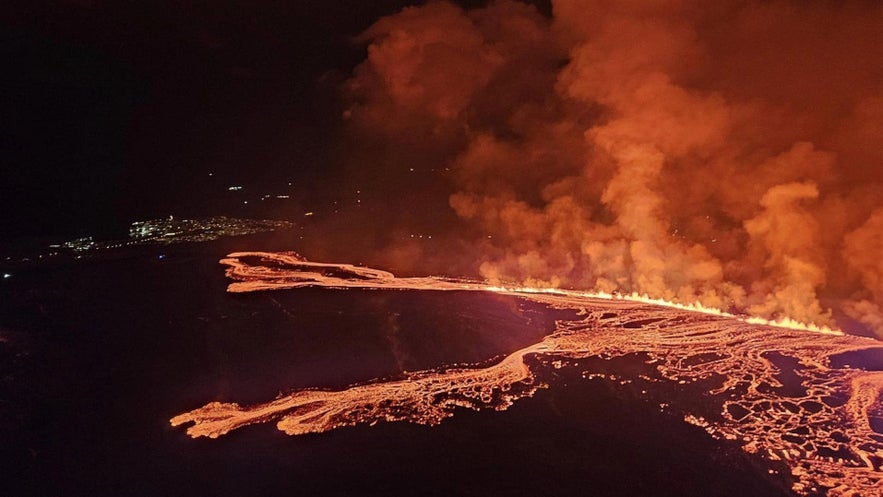
The eruption that began in Sundhnukagigar on March 16th gave very little notice of its forceful entry. The fissure was roughly 2 miles long (3.5 kilometers), and it quickly became apparent that it was more powerful than its February counterpart.
The lava flow from the eruption was initially very fast, flowing in two directions - the south and the west. Thankfully, the preventative measures of erecting mounds of earth to slow the lava flow proved useful in guiding it away from infrastructure. The lava flow stabilized within the first 24 hours, slowing down and forming craters.
The main concern of this eruption by Grindavik was the vegetation fires as lava spread over the dry landscapes. Notably, the flow filled up the Melholsnama mine, the source of the material used for the protective barriers that surround Grindavik, the Svartshengi powerplant, and Blue Lagoon.
The eruption maintained a consistent level of activity, characterized by a series of craters continuously erupting. By April 5th, activity had reduced to just one active crater. The eruption ultimately concluded on May 8th.
May 29, 2024
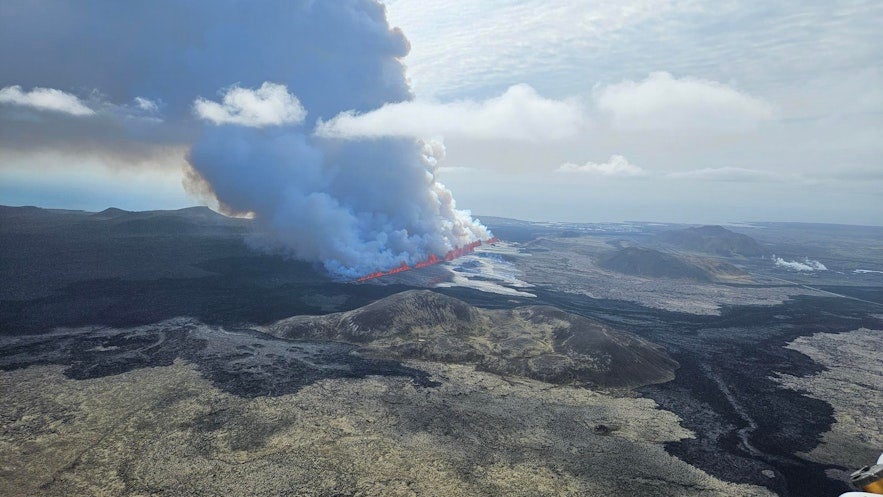 It didn't take long for the next Sundhnukagigar eruption to take place as lava continued to collect underground. On May 29th, the ground on the Reykjanes peninsula opened for the fifth time in four years, forming a 2.1-mile (3,4-kilometer) long fissure. It was the most powerful eruption in this row of events so far, and lava spewed 164 feet in the air (50 meters) and extended the new lava field from previous eruptions.
It didn't take long for the next Sundhnukagigar eruption to take place as lava continued to collect underground. On May 29th, the ground on the Reykjanes peninsula opened for the fifth time in four years, forming a 2.1-mile (3,4-kilometer) long fissure. It was the most powerful eruption in this row of events so far, and lava spewed 164 feet in the air (50 meters) and extended the new lava field from previous eruptions.
This May eruption caused electricity outages in Grindavik, and lava flowed over the Grindavikurvegur and Nesvegur roads. In one spot, some lava went over one of the protective barriers and was cooled down with water. Thankfully, locals were able to stop the flow and fix the barriers.
The volcanic activity lasted for a while but developed similarly to the previous eruptions, slowing down after the first few days. It was officially declared over on June 22nd.
August 22, 2024
 Around 9 PM on August 22nd, there was a sudden increase in earthquakes around the Sundhnukagigar craters before the earth opened up for the ninth time in four years. Small earthquakes were felt around the Capital Area, including one that measured 4.1 in Magnitude.
Around 9 PM on August 22nd, there was a sudden increase in earthquakes around the Sundhnukagigar craters before the earth opened up for the ninth time in four years. Small earthquakes were felt around the Capital Area, including one that measured 4.1 in Magnitude.
The erupting fissure quickly extended to 2.5 miles (4 kilometers) in length, and a few hours later, another smaller fissure opened further to the north, measuring around 0.6 miles in length (1 kilometer). At that point, the earthquakes calmed down as pressure was released from the earth.
To begin with, the lava flow was around 1.2 miles (2 kilometers) per hour but quickly slowed down. The activity is also centered more on the north of previous eruption sites, a more convenient location for protecting nearby infrastructure, but it raised some new challenges.
The area was used as a practice site by the United States Army between 1952 and 1960 and is known to hide remains of weaponry, including still active landmines. This meant that if people chose to ignore the safety closure and tried to hike to the eruption area, there was a chance that they would get injured on the way while crossing the area.
Thankfully, most people respected the closure, and the eruption finally came to an end on September 5th. It would be almost two months until the next one.
November 20, 2024
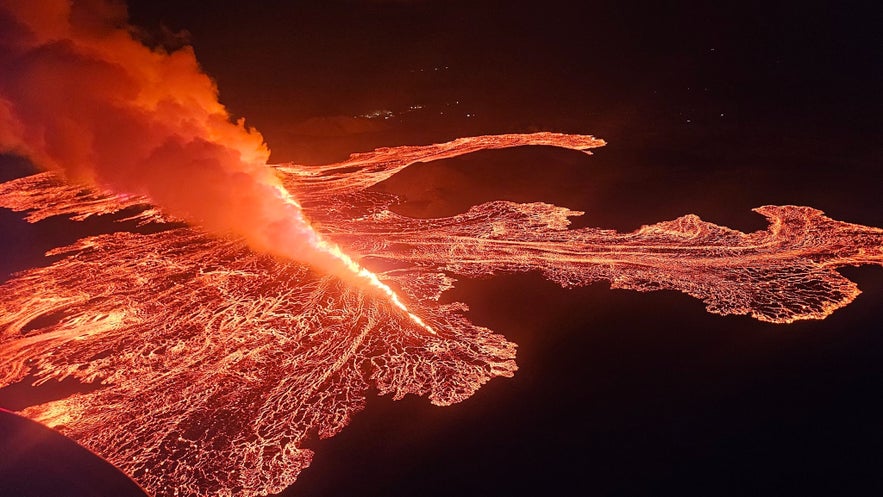 After weeks of no activity, the Earth by Sundhnukagigar opened for the 7th time on the evening of November 20th. This marked the 10th eruption on the Reykjanes peninsula since Fagradalsfjall volcano in 2021.
After weeks of no activity, the Earth by Sundhnukagigar opened for the 7th time on the evening of November 20th. This marked the 10th eruption on the Reykjanes peninsula since Fagradalsfjall volcano in 2021.
As with the previous eruption, the craters opened further north of Grindavik, sparing nearby infrastructure from direct threats. However, the lava flowed over the main road to Grindavik and severed some power lines, causing a temporary electricity outage in Grindavik. It also flowed over the parking area of the Blue Lagoon, but thanks to the protective barriers around the area, there was no risk to the spa or other infrastructure.
The volcanic fissure reached a length of 3 kilometers (1.8 miles) overnight but then started forming craters, and activity slowed down. Flights and travel within Iceland remained unaffected, and daily life for locals continued as usual.
This November eruption came as a surprise, as scientists had recently predicted that volcanic activity wouldn't resume until December at the earliest. However, the eruption came to a close on December 9th, having lasted for 18 days.
Based on the recent patterns, more eruptions are likely in the coming months, though the timing remains unpredictable. The eruption site is currently off-limits to the public and can only be viewed through helicopter tours.
April 1, 2025

After a quiet start to the year, the Reykjanes Peninsula experienced its latest volcanic eruption on the morning of April 1, 2025. Just after 7:30 AM, tremors were felt near Grindavik, prompting a swift evacuation as signs pointed to rising magma beneath the surface.
Lava traveled more than 6 miles (10 kilometers) underground before breaking through around 9:30 AM. This eruption occurred further south than previous ones in the Sundhnukar Crater System, bringing it unusually close to the town.
One section of the fissure breached a protective barrier built to shield Grindavik, but the eruption itself remained relatively small in scale. Authorities determined the lava was unlikely to reach the town, and by the afternoon, volcanic activity had already begun to subside.
By April 2, the eruption appeared to have ended, though minor tremors continued, suggesting the potential for further magma movement. However, no additional surface activity followed, and the event gradually came to a close.
Lava continues to accumulate beneath the region, indicating that more eruptions are likely in the future. While it’s impossible to predict when this overall volcanic period will end, the Sundhnukagigar eruptions have had no impact on travel in Iceland.
July 16, 2025
 On July 16, 2025, a volcanic eruption started on the Reykjanes Peninsula, marking another significant event in the region's ongoing volcanic activity. The eruption began shortly after 4:00 AM, following a series of strong earthquakes. By 5:00 AM, a fissure opened, stretching 1.2 miles (2 kilometers) and releasing lava into the air.
On July 16, 2025, a volcanic eruption started on the Reykjanes Peninsula, marking another significant event in the region's ongoing volcanic activity. The eruption began shortly after 4:00 AM, following a series of strong earthquakes. By 5:00 AM, a fissure opened, stretching 1.2 miles (2 kilometers) and releasing lava into the air.
As a precaution, Grindavik and the Blue Lagoon were evacuated, but the location was actually considered safe for infrastructure.
By the afternoon, the eruption had slowed, but it continued on for almost a month, coming to a stop on August 5th. Travel to Iceland remains safe, with no disruptions to international flights or major tourist attractions.
Sundhnukagigar Volcano in 2026
As of 2026, there have been no new eruptions at Sundhnukagigar since the July 2025 event. Scientists continue to closely monitor the area, as small, steady earthquakes are still occurring and magma continues to accumulate underground. This means that while another eruption is possible in the future, there are currently no signs that an eruption is imminent or will happen at all.
For travelers, this means that visiting Iceland remains safe, and daily life in the Reykjanes Peninsula continues unaffected. Iceland’s volcanic activity is carefully tracked by authorities, and any changes are communicated well in advance.
At present, there is no active eruption in Iceland, no risk to visitors, and flights, tours, and attractions are operating as normal.
Events Preceding the Eruptions

The eruption in Hagafell in January 2024 had come as a terrible blow to the people of Iceland, especially the residents of Grindavik, whose homes were damaged by the earthquakes. The flowing lava destroyed three houses, and many other homes and infrastructure were destroyed by enormous cracks in the earth created by earthquakes and seismic activity.
Thankfully, no people or animals were harmed in the eruption, as everyone had been evacuated. The preceding earthquakes, which numbered in the thousands, had given the Icelandic people fair warning, and an eruption had been expected for roughly two months.
Just a few months before the eruption in Hagafell, another eruption that took place in Sundhnukagigar had resulted in what experts called a "best-case-scenario," as the lava flow from the eruption, while close to Grindavik, flowed in the opposite direction from the town.
Throughout 2024 and 2025, eruptions occurred farther from Grindavik and posed a reduced risk to the town. In July 2025, some residents were able to return to their homes, and Grindavik has since reopened to the public.
A small number of businesses have resumed operations, and in December 2025, locals were able to celebrate Christmas in their homes for the first time in two years. While recovery is progressing gradually, there is cautious optimism that it will continue in the months and years ahead.
Understanding Reykjanes Volcanic Activity Today

The series of eruptions in Reykjanes began in 2021 with the volcano of Fagradalsfjall. The eruption was a visitor-friendly spectacle with tens of thousands of people flocking to see it from all over the world. The same was true for the second eruption by Fagradalsfjall in 2022 and the eruption of Litli-Hrutur in 2023.
The seismic activity in Reykjanes is caused by its location on the Mid-Atlantic Ridge, the rift between the North American and Eurasian tectonic plates. If you want to learn more about the geology behind the eruptions, see our article on tectonic plates in Iceland.
Despite the ongoing volcanic activity, Iceland remains a safe destination for travelers. The country has extensive monitoring systems in place to ensure the safety of locals and visitors alike.
You can still explore Iceland’s stunning landscapes, experience the famous Blue Lagoon, and enjoy the many other attractions across the island without concern.
The volcanic activity of the Reykjanes peninsula is expected to continue developing in the coming years. Have you seen any of them during a visit to Iceland? Let us know in the comments if you have any questions, and we will do our best to answer them!

